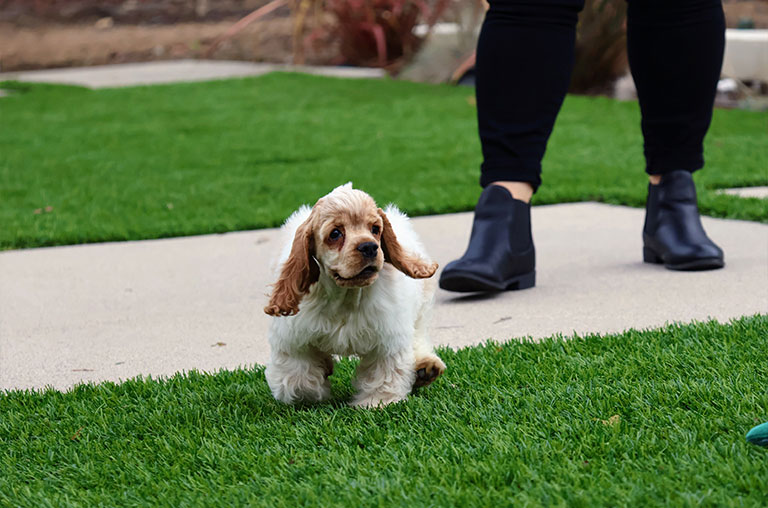Is your dog walking in circles? Is it frequent or just occasional? Dogs exhibit some peculiar habits that might get you worried at times. They may wander, chew grass, roll in the dirt, sniff other dogs, or do all the above. What causes these dogs to circle repeatedly?
Nothing is sometimes wrong, as their actions indicate an underlying problem that requires behavioral or medical attention. What will you do when it becomes unbearable?
Understandably, the misconception that dogs circle before sitting or relaxing is recurrent. This notion is entirely unfounded. Something might be wrong when you face a dog acting this way. Read more as we share the primary reason behind this and solutions to stop your dog walking in circles.
What does it mean when a Dog walks in circles around You
It’s common for a dog to do two or three laps around the room before settling down. How do you distinguish between this and their “circling behavior,” a symptom of potentially life-threatening conditions?
If you watch a dog with compulsive circling behavior, you will realize they always turn in the same direction. If you try to divert their attention and steer them in a different direction while circling, they will have difficulty doing so and may run into obstacles.
There is a correlation between time and the frequency with which circling behavior occurs. You may not even notice that your dog is circling at first because they may just be walking in a circle more frequently but always in the same direction. Over time, they will rely less on walking and more on circling.
Common causes of Dog walking in circles
Your dog spinning in circles and panting is rarer than chasing its tail or making other erratic movements, all of which are common in pups and even fully-grown animals. It may be common for some dogs to do this before bedtime or before going to the bathroom.

For most dog owners, it’s odd to see their dog start circling, especially if it’s the first time this action has happened. While you might not consider this action initially, the issue might get extreme if you don’t do the needful.
However, when your dog walking in circles becomes frequent, it could be a red flag that something is wrong. Here are some common reasons you might find your dog walking in circles and spinning.
Ear infection
An inner ear infection is a common reason for a dog to wander. However, they will require quick medical attention when the condition becomes severe. Other symptoms include a foul odor from the ear region, blurred vision, and constant head shaking.
If you suspect an ear infection is the reason for your dog’s confusion and circling behavior, you should see a vet as soon as possible, even though home cures for ear infections are typically effective.
Hypothyroidism, allergies, and immune system disorders can cause recurrent ear infections. In addition, mites, poor ear hygiene, and swimming can always lead to ear infections. If they are circling because of an ear infection, it is severe and has spread deep into the ear canal.
How to treat ear infection
An inner ear infection is serious since it extends beyond the ear canal and can even spread to the brain. Topical treatment won’t work if the eardrum is still intact. Eardrops are not likely to be effective even in cases of a ruptured eardrum. Your dog will need to take oral antibiotics. Nevertheless, consult your veterinarian, who will recommend a thorough ear cleaning and medicines.
Inflammatory brain disease
Brain inflammation is another possible reason the dog walks in circles and is disoriented. Meningitis can affect the membranes that cover and protect the brain. It’s possible that the old dog’s continuous circling is the result of a neurological condition.

A lack of appetite, nausea, vomiting, chills, and a high temperature are all symptoms of an inflammatory brain disease. Neurologically impaired dogs are likewise not likely to be able to interrupt their circling behavior when distracted.
The best approach to dealing with a dog walking in circles due to inflammatory brain disease is to visit the vet for a supplement that might help your dog. If your dog is experiencing neurological issues, talking to your vet before giving them supplements like omega-3 fatty acids, turmeric, or MCT oil is a good idea. However, give your dogs these supplements with your vet’s permission because of the risk of drug interactions.
Vestibular syndrome
Vestibular syndrome is a disorder of the inner ear that can impair your dog’s balance and is more prevalent in old dogs. Although the syndrome’s exact cause is unknown, ear damage due to an infection, an injury, or malnutrition is a contributing factor.
Other severe symptoms, such as frequent falls, heavy drooling, and walking with their head down, are likely to follow the circling. In most cases, dog owners misinterpret these symptoms as strokes.
If your old dog keeps walking in circles or shows these signs, a trip to the clinic is necessary. Antibiotics, corticosteroids, and antifungal or antiepileptic drugs are all part of the treatment plan.
How to treat Vestibular Syndrome
Nursing care is an integral part of home treatment for vestibular illness in dogs. Make it so your dog can’t resist staying in bed with you by propping up its head. If they can’t get up, you’ll have to change the sheets more often, help them walk with a sling, or take them to the bathroom.
Don’t be surprised if they refuse to eat after being offered water and modest portions of delectable food. If your dog walking in circles situation is severe without you able to provide the necessary care at home, or if 48 hours have passed with no signs of recovery, it is best to visit a vet. Your dog might be given IV fluids to prevent dehydration, depending on the condition.
Dementia or Canine cognitive dysfunction (CCD)

Canine cognitive dysfunction, or “doggy dementia,” is the gradual loss of mental capacity in old dogs. Because of this, your dog loses its ability to remember, behave, and move normally.
Canine dementia can cause a dog to become disoriented. When you see your dog walking in circles and falling over, it might be showing signs of CCD. Other changes in behavior you might experience include forgetting house training or where the food bowl is kept. Your dog can become aggressive in certain situations since it remembers nothing.
How to treat
Dementia in dogs is currently incurable. The condition might get worse as time progresses. However, some nutritional supplements and mentally challenging activities can help lessen the condition.
Fortunately, you can control CCD using nutritional supplements and mental and physical exercise. You can reduce symptoms by giving your dog food with antioxidants and omega-3 fatty acids.
Behavioral Disorders
Some dogs’ behavioral issues can cause them to wander aimlessly, much as they might in people. For instance, it’s common for dogs to acquire OCD, which can lead to behaviors like your dog walking in circles repeatedly in the same area.
Though you might not see any outward signs of illness, such as drooling or blurred vision, you might notice that this isn’t the only behavioral pattern you’ve seen from them.
Anxiety can also stimulate circling behavior, albeit it is typically associated with traumatic events such as exposure to thunderous noises such as fireworks. A comparable reaction might result from long periods of confinement in a space that is too small for them or a lack of mental or physical stimulation. You can follow these tips on how to keep your dog safe during fireworks to ensure safety upon such events.
How to treat
Avoid exposing your dog to anything that could set off their anxiety and give them plenty of opportunities to run about and use their brain. The severity of these conditions is proportional to their manifestations and associated symptoms.
Pain and Injury

Some dogs’ disorientation and circling behavior can be attributed to a ruptured eardrum. A loss of equilibrium is a common symptom of head trauma. Dogs are experts at disguising their suffering, so it’s essential to investigate whether or not environmental factors contributed to any injuries.
If you’re unsure what causes the dog spinning in circles and whining, keep an eye out for symptoms, including increased respiration rate, pacing, resistance to lying down or interacting with you, decreased hunger, and whimpering during sleep as a result of pain.
Ataxia
Each of the numerous disorders categorized as ataxia has its distinct signs and symptoms. The two main vestibular ataxias are the inner ear and brainstem involvement.
Once again, underlying conditions like inner or middle ear infections, tumors, or skull or ear trauma can play a role. Infections and inflammations are the most common causes of brainstem dysfunction, but thiamine deficiency and Metronidazole poisoning (an antibiotic) also play a role, albeit less commonly.
Some of the causes listed above may also lead to problems with the cerebellum or spinal cord. If you have any reason to suspect that ataxia is the cause of your dog walking in circles, consulting your veterinarian will be the best option to consider.
Diagnosing Your Dog
It’s not always obvious whether their incessant circling indicates a more serious issue that’s out of their control or that they’re being odd.
If your dog is circling, you can determine whether this behavior is under their control by distracting them while they are circling and encouraging them to move in a different direction. Your dog’s reaction to changing directions indicates that the issue is not neurological.
Check their eye contact to see if they are paying attention and if they have trouble changing directions. Signs of a brain injury (as opposed to an ear infection) include incoherent eye movement or dilated pupils.
However, if your dog has lost all sense of self-control and experienced a dog spinning in circles seizure, it’s time to take them to the clinic. To determine what’s wrong with your puppy, a professional vet will perform several tests like these and ask about any additional symptoms you’ve noticed.
Dog walking in circles: What to do?

Obviously, your vet’s recommendations for treating your pet’s pacing, circling, and other obsessive habits will depend on the underlying problem.
Oral medication administration, medications to treat the infectious component, if any, and potential surgical options in the case of tumor growth as the causative ailment are all examples of treatments that might be used if a systemic condition is determined to be the underlying cause of the patient’s symptoms.
Your veterinarian can also suggest dietary adjustments if he suspects poor nutrition is to blame for your pet’s health problems. When the cause is environmental or behavioral, he may recommend adjusting your pet’s routine or home environment to stop your dog walking in circles.
If your veterinarian conducts several tests on your pet and concludes that everything is fine and your pet has a behavioral problem (without a systemic component), and if the behavior persists for more than a few days, he may recommend seeing an animal behaviorist. Dementia in dogs is incurable. However, you can control the situation with nutritional supplements, special diets, and a change in your dog’s lifestyle.
Events relating to Dog walking or running in Circles
Why Is My Dog Running in Circles?
If your dog is running in circles, several factors could contribute to this behavior. Playful energy, excitement, or a desire to burn off excess energy are common reasons. Dogs might also engage in circular running due to sensory stimulation or attempting to find a comfortable spot for rest.
However, if the circling becomes obsessive or is accompanied by signs of distress, it’s crucial to rule out underlying issues like ear infections, neurological conditions, or pain. Observing the context and consulting with a veterinarian can help decipher whether your dog’s circular running is a playful quirk or a sign of an underlying concern.
Why Does My Dog Circle Me?
If your dog circles around you, it’s likely rooted in natural instincts. Dogs have a tendency to circle or pace before lying down, a behavior inherited from their wild ancestors. This circling instinctually fluffs up the surrounding area to create a comfortable bed.
Additionally, circling may be a way for your dog to mark its territory by leaving scent glands on the ground. While this behavior is often harmless, constant or obsessive circling could indicate discomfort or anxiety. Pay attention to your dog’s overall demeanor, and consult with a vet if you have concerns about their behavior.
Why Does My Dog Spin in Circles When He Sees Me?
If your dog spins in circles upon seeing you, it’s likely an expression of joy and excitement. This behavior is a common canine greeting, and your dog is showcasing sheer happiness to be in your presence.
Dogs often engage in this joyful spinning as a way of releasing pent-up energy and expressing their exuberance. It’s a positive and affectionate reaction that highlights the strong bond between you and your furry friend. Embrace this delightful display of enthusiasm as your dog’s unique way of expressing love and anticipation.
Why does my blind dog walk in circles?
Wonder why your blind dog walks in circles? It’s a behavior rooted in sensory exploration and adaptation. Blind dogs use circling as a means to assess their surroundings, relying on heightened senses of smell, touch, and hearing. This repetitive behavior helps them create a mental map of their environment.
However, persistent circling may indicate anxiety or uncertainty. Providing a consistent and safe living space is crucial for their well-being. Regular veterinary check-ups ensure their health, addressing any potential concerns. Understanding and accommodating your blind dog’s unique behaviors contribute to a fulfilling and supportive companionship.
Dog walking in circles: FAQ
Why does my dog spin in circles constantly?
Pacing and circling can be normal behaviors that dogs do to do normal things like urinate, poop, sniff, and look around, or they can be abnormal, compulsive behaviors that dogs do all the time. They could also be signs of pain, a nervous system illness, or even dementia in dogs. You will discover that your dog has some health challenges, as mentioned above.
What are the warning signs your dog is crying for help?
When a dog licks, bites, or grooms one part of his body more frequently than usual or for a more extended amount of time than expected, it may be attempting to tell you he is in pain and needs assistance. The best option is to look for wounds or swelling. Your last option is to take your dog to the vet to check what might be the cause.
Is a symptom of dog dementia walking in circles?
Canine cognitive dysfunction (dog dementia) is characterized by behavioral abnormalities in old dogs, including pacing and circling, as well as other symptoms like disorientation, changes in sleep and/or eating, potty accidents, and becoming withdrawn. Therefore, when you see your dog walking in circles, it might be experiencing dementia.
How do I stop my dog from spinning?
You shouldn’t wait to see a vet if you see your dog walking in circles. Usually, this is a sign of a significant neurological problem that makes the front part of the brain not work right. Assuming you have tried every home treatment possible without any improvement, don’t hesitate to visit a vet doctor. If your doctor thinks your pet has a brain problem, they will send you to a veterinary neurologist for brain imaging.
What are the first signs of Cushing disease in dogs?
Dogs’ Cushing’s symptoms differ. It usually starts with thirst. It feels dehydrated. Dogs naturally urinate more due to excessive thirst and drinking. Dogs will also eat more. Cushing’s disease has various symptoms: reduced activity, heavy panting, hair loss, and repeated skin infections.
Dog walking in circles: Conclusion
You should be concerned if your old dog suddenly starts walking in circles. A trip to the vet is advised, even if the problem may be minor. Stress, ear infections, vestibular syndrome, behavior disorders, canine cognitive failure, or neurological diseases are all possible causes of your dog walking in circles. The sooner you identify the problem, the sooner treatment can begin, and your dog can return to being a happy, healthy family member.

Leave A Comment